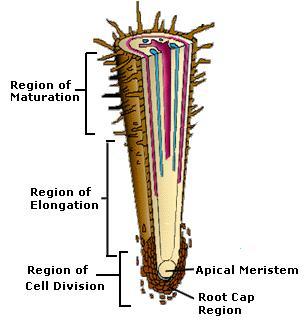11th And 12th > Biology
TRANSPORT IN PLANTS MCQs
Identify the correct statement related to water movement in deeper layers of the root.
A. Apoplastic movement of water does not involve the crossing of the cell membrane.
B. Symplastic movement is aided by cytoplasmic streaming.
C. Most of the water movement in the root is through symplast.
D. Water movement through the root layers is ultimately symplastic in the endodermis.
:
D
Most of the water flow in the roots occurs via the apoplast since the cortical cells are loosely packed and hence offer no resistance to water movement. But movement through the endodermis layer alone is symplastic.
:
B
Higher the solute concentration, higher the osmotic pressure. Thus, the osmotic pressure is directly proportional to the solute concentration.
Identify the correct set of statements related to the movement of substances through vascular tissues.
I. Xylem mainly translocates water, minerals salts and also organic solutes.
II. Phloem mainly translocates a variety of organic solutes and also inorganic solutes.
III. Xylem transports substances from roots to aerial parts of the plants.
IV. Phloem transports substances bidirectionally.
:
D
I, II, III & IV are the correct set of statements related to the movement of substances through vascular tissues.
Xylem transports mainly water, mineral salts, and inorganic solutes from the roots to aerial parts of the plant. Although it was traditionally believed that xylem transported only water and minerals, xylem sap analysis shows the presence of some organic solutes also. Especially elements such as nitrogen, some amount of sulphur and phosphorous are carried as amino acids and related compounds. Similarly phloem too transports inorganic solutes, though they primarily transport sugars and other organic solutes, however here the transport is bi-directional from leaves and storage organs to other parts.
:
C
The process of transpiration is responsible for the force that pulls water up in a very tall tree. It is responsible for the transpiration pull that causes the ascent of sap.
:
B
False. Transport of substance against the concentration gradient is impossible without the expenditure of energy. The transport can be done without the usage of energy as long as it is along the concentration gradient.
:
Pressure potential in any cell is created by the water present in the cytoplasm. When the water inside the cell comes out, the pressure on the cell wall becomes zero.
:
Due to the presence of sucrose in the sieve tube cells water enters into sieve tube cells and a hydrostatic pressure builds up. At the sink osmotic pressure is reduced as sugars and removed. Hence water flows out of phloem and into the sink, reducing the hydrostatic pressure in the phloem vessel. This gradient in the hydrostatic pressure facilitates the mass movement in the phloem.
:
A
Active transport uses energy to pump molecules against concentration gradient i.e from the region of lower concentration to higher concentration and hence the transport is referred as uphill transport.
:
A
Pure water has the highest water potential and by convention water potential of pure water is taken as zero.

















